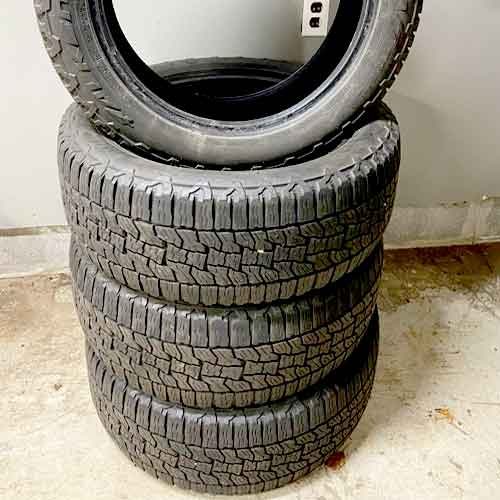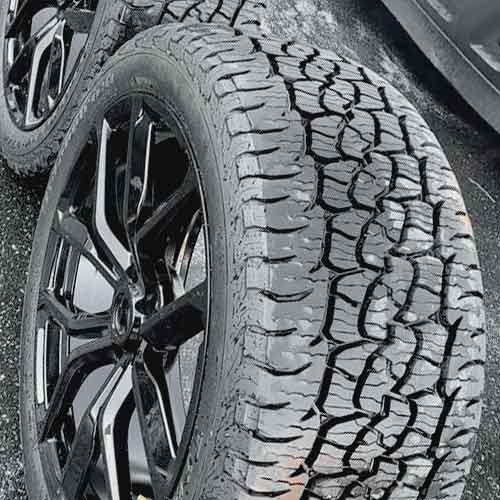Both the BF Goodrich Trail Terrain and the Falken Wildpeak A/T Trail are all-terrain tires, suitable for both on-road and light-duty off-road driving. Their designs are smooth, making them ideal for highway use in both dry and wet conditions. Additionally, they offer a wide range of load ratings, making them compatible with full-sized SUVs, crossovers, and pickup trucks.

As a tire engineer, I can share that while the BF Goodrich Trail Terrain is very much aligned with on-road use, its dry and wet grip is comparatively unimpressive. However, it excels on rugged tracks, including mud, rocks, and gravel. In contrast, the Falken Wildpeak A/T Trail provides excellent traction, leading in handling times and braking distances by a significant margin. Yet, this tire is not as fuel-efficient and is less wear-resistant than the BF Goodrich Trail Terrain.
Sizes Info
The BF Goodrich Trail Terrain is available in sizes ranging from 15 to 22 inches. Its specifications include:
- Speed Ratings: T and H.
- Load Ratings: XL and SL.
- Tread depth: 12.5/32″ across all sizes.
- Weight Range: 30 to 46 lbs.
- 60k Miles warranty.
The Falken Wildpeak A/T Trail, on the other hand, is available in sizes from 16 to 20 inches, with the following specs:
- Speed ratings of H and V.
- Load ratings of SL and XL.
- Tread depth: 10 or 11/32″.
- Weight Range: 25 to 42 lbs.
- 65k miles warranty.
Tread Design
The Falken A/T Trail consists of a 5-rib, closely packed design, where two wider circumferential channels divide the middle area of the tread from the shoulders.

The central part of the tread has 3 ribs containing lugs that run in pairs (as they are joined from underneath to each other).
Combined with notches, the tire enhances its dry grip, whereas full-depth siping provides grip in wet and snow conditions.
Moreover, with the highly angled positions of these lugs, the tire forms very tough passing circumferential grooves, allowing for off-road bite as well.
The surrounding ribs, while carrying similar features, also have additional biters in the form of stepped edges, to provide further off-road grabbing.
Moving towards the shoulders, here the lugs are slightly more elongated, and they create a similar, but slightly more aggressive siping pattern of interlocking design.
Though, towards the outer margins, they are not staggered, but they do form a bit of a pattern there as well.
But keep in mind, these biters are only effective when you run this tire with lowered air pressure (PSI values).
Moving on towards BF Goodrich Trail Terrain. Let’s start off with its edges.

This tire has staggered shoulder blocks and slanted sidewall lugs with deep biters.
Its sidewall lugs are very similar to those of the KO2, (see their comparison here).
The shoulder blocks don’t divide up properly because there is a continuous rib with traction notches throughout.
These ribs on each side of the tire form circumferential channels that divide the central blocks.
In the middle, the compactly packed blocks have sharp offset edges and full-depth siping, that splits them all the way to the base, providing strong biting power off-road (where needed).
Moreover, although the tire does not have traditional stone ejectors, it does have triangular ones strategically placed in the grooves.
Dry Performance
Dry performance is divided into 3 main sections: namely, dry grip, handling, and responsiveness of the steering. So, let me split this into these sections.
Dry Grip
While all-terrain tires are expected to meet a certain standard of traction on dry roads, things are not as challenging. Though still, there’s a lot of gap in performance between these two.
Dry grip (also called directional grip) basically looks at the central tread section of the tire. And, the Falken WildPeak A/T Trail is doing better here, as it makes better on-road connection, with its relatively more packed middle-most lugs, particularly.
Moreover, as all its lugs have more robust reinforced foundations, the tire also provides you with solid on-center feel. Which is basically the measure of, how quickly the tire stabilizes/straightens after the corner.
In comparison, the BF Goodrich Trail Terrain, being more voided up, isn’t able to provide you with the same level of grip, and overall stability.
Sideways Grip and Stability
Sideways grip, also known as lateral traction, is a measure of a tire’s ability to corner and is based on how well the shoulders are designed.
This is because as the tire turns, the tread edges get the most (concentrated) weight on them. Meaning, these shoulder lugs makes the most contact with the road, as the tire corners.
Having said that, although the BFG Trail Terrain provides continuous-running shoulders, forming consistent contact with the road, it still lacks to its counterpart.
The Wildpeak A/T Trail, simply put, provides a lot more biting edges, resulting in superior grip, (as seen by its grater lateral g forces on average, on tests).
Additionally, the lighter weight of the Wildpeak A/T Trail enhances its stability. This reduced weight, coupled with a robust construction, means its lugs are less prone to bending.
This is crucial because when lugs bend, they take “time” to revert to their original shape. And that time is actually the “delay”, you get between steering inputs and responses.
Consequently, unlike the BFG tire, the Wildpeak A/T Trail is less susceptible to understeering. This results in greater stability and faster handling response times, as demonstrated in lap tests.
This combination of features positions the Wildpeak A/T Trail as a superior choice for enhanced performance and quicker steering response.
For Your Info: Out of these tires’ direct competitors, the Nitto Nomad Grappler (review), provides better steering responsiveness.
Fuel Consumption
The more the resistance to “Roll,” the more fuel energy a tire would use.
This resistance is affected by two main factors: tread composition and the tire’s overall weight. These factors determine the pressure exerted on the tread lugs and their ease of movement, with some tread compounds offering more resistance due to their stickier nature.
Having said that, the Falken Wildpeak A/T Trail, despite its lighter weight, it tends to consume a bit more fuel, comparatively.
This is mainly because the tire’s tread with more biters, is slightly more adhering. So this although enhances the tire’s grip, it comes at a cost of higher rolling resistance.
Conversely, the BF Goodrich Trail Terrain features a rounded contact patch, which excels in evenly distributing pressure across its lugs.
This design results in lower rolling resistance, contributing to better fuel economy.
However, it’s important to note that this efficiency in fuel consumption comes with a trade-off in the grip department, as previously mentioned.
Nonetheless, the tire stands out as one of the top-performing designs for fuel efficiency among all-terrain tires.
Speaking of which, you should check out my list of top A/T tires: https://tiredriver.com/best-all-terrain-tires/
Wet Performance
When evaluating tire performance on wet surfaces, the key lies in the design of the tread’s grooves and sipes.
Grooves are the large channels that effectively disperse water from beneath the tire, while sipes, the smaller cuts in the tread, act like sponges to remove residual moisture.
This aspect highlights a significant shortcoming of the BF Goodrich Trail Terrain, where its primary weakness is its inability to efficiently channel water away from the tread, with the help of grooves, I mean.
This is largely due to its shoulder ribs, which feature continuous, unbroken patterns that impede lateral water evacuation, for the most part.
And so with reduced water displacement by the grooves, there’s an increased reliance on the sipes. And that’s the thing the tire doesn’t offer good enough sipes either, especially when compared to Wildpeak AT Trail, which comes with aggressive 3D wave-like siping.
These sipes basically maintain their effectiveness even during extreme maneuvers, offering consistent wet traction from various angles.
So overall, the Flaken’s tire not only provide you with better hydroplaning resistance here, but also wet traction.
Tread Life
When it comes to how quickly your tire treads wear down, there’s more to it than just rolling resistance. You’ve also got to consider things like tread depth and what the tread’s made of.
Now, out of both tires, the Falken Wildpeak A/T Trail offers better tread longevity, as its lugs sit on a stiffer secondary rubber layer underneath, and this combined with its lighter weight, the tire offers better results, even though its tread depth is lower compared to its counterpart.
Now, the difference in wear between these two isn’t huge.
This is partly because the BF Goodrich has lower rolling resistance, which helps slow down the wear and tear. That’s why Falken only offers a slightly better mileage warranty, I mean we’re talking about an extra 5,000 miles only.
For Your Info: Tires with more tread depth take longer to get down to that 2/32″ mark, which is the legal tread limit in the U.S. But remember, there’s a balance to strike here. More tread depth can mean more rolling friction, which might speed up wear in some cases. It’s all about finding that sweet spot!
Ride Quality
In my view, the key factors for a tire’s smooth ride include its stability, effectiveness in reducing road bumps, and noise suppression. Let’s discuss all one by one.
Tread Noise
Now, noise gets generated with air particles entering the tread (mostly through shoulder voids), and hitting the tread walls.
This basically creates primary source of noise, that then goes on and generate in-groove resonance, that occurs when noise waves echo within the tread.
Now, here, both tires do a pretty good job, providing you with very similar performance, as seen by their similar decibel readings (on averaged test results).
With the BF Goodrich Trail Terrain, its design tackles noise right at the source. The shoulder lugs are closed up, which minimizes the amount of air that can enter and bang around in the tread, resulting in a quieter ride.
On the other hand, the Wildpeak AT Trail approaches the noise issue with a different strategy, where it features a variable pitch tread design.
With this, the lugs are geometrically altered, in a way, that air particles hitting them, could produce varying tones and frequencies.
These differing tones essentially try to cancel each other out. It’s a neat bit of engineering that helps reduce the overall noise level.
Impact Comfort
Impact comfort is all about how well the tire dampens down the road imperfections.
And here, the BFG Trail Terrain has the upper hand. This is because for one, the lugs on the tire’s tread have more flexibility, so they tend to bend more easily against the road, absorbing irregularities better.
Moreover, although both tires have similar inner construction on paper, with 2 ply polyester, twin steel belts, and single polyamide cap ply, the BFG inner build is relatively softer, cushioning against bumps better.
Winter Traction
Now, although both of these are rated with 3 peak mountain snowflake rating, the BF Goodrich Trail Terrain still has the upper hand. In fact its one of the best on-road oriented A/T tires for snow.
So what makes this tire so great?
Well, it’s all about how its optimized for generating snow-to-snow contact.
Basically, this tire is excellent at maintaining contact with the snow on the ground while simultaneously shedding excess snow.
This snow-to-snow contact is crucial because snowflakes naturally interlock with each other, creating more grip and friction than rubber-to-snow contact.
Another point in its favor is the design of its sipes.
While they might not be the best for wet roads, they’re brilliantly optimized for winter traction. The sipes are deep and effectively cut into the snow, which is key for stable handling and braking in snowy conditions.
To give you an idea about the tire’s performance, it excels by a huge margin compared to the Wildpeak AT Trail, particularly on braking tests. We’re talking about 10 feet shorter on ice and 9 feet shorter on snow. TireRack also tested it, by the way, and got similar results.
FYI, if you need to learn more about all-terrain tires performance on snow, you should check this out: https://tiredriver.com/are-all-terrain-tires-good-in-snow/
Off Road Traction
All-terrain tires need to find a middle ground between both worlds (on/off roads), and it’s always been a long-lived battle when it comes to traction on both.
So, with both these tires focusing more on highway performance, you can’t expect too much out of them on rugged tracks, but still, which one is better? Well, to answer this, I evaluated their traction on different types of terrains. Let’s dig in.
On Sand
Driving on sand can be tricky, as the key is to avoid digging into it. Once a tire starts digging, it’s often a fast track to getting stuck.
Now, out of both tires, the BF Goodrich surprisingly takes the lead here, despite being the heavier of the two.
Now, one might think the extra weight would lead to more digging, but that’s not the case here. This is because the tire’s continuous running shoulder lugs, provide a lot of contact patch to meet with the sand.
This increased contact area helps to distribute the weight more evenly, reducing the chances of digging in.
Additionally, the tire offer thicker and better sidewall lugs, which with lowered air pressure add further to the tire’s contact patch improving overall grip.
On the other side, the Wildpeak AT Trail lacks with missing sidewall lugs, and sharper shoulder edges, meaning its design is more prone to digging in sand, despite being lighter.
I discussed all about sand traction of A/T tires here: Are A/T tires good on sand?
On Mud
On muddy terrains, you need balder tires, and although both tires are pretty packed up, the Wildpeak A/T Trail still offers better mud evacuation.
That’s because the BF Trail Terrain has closed-up shoulder ribs, restricting mud sideways flow, predominately. Though it still offers a little bit of traction from sidewalls, where its thicker lugs provide the needed digging and scooping.
On Rocks
Sidewalls provide lateral grip, whereas the central lugs with biters ensure gripping from the middle. And you need both for climbing rocks, along with durability as well, of course.
And here although both tires are not tough enough internally, at least you get to have thicker sidewall lugs on the BFG Trail Terrain, so with that, combined with its staggered shoulders, you get to have better lateral traction overall.
And from the middle, with a softer compound and larger grooves, you also get superior bite from there as well.
That’s why the BFG gets to provide you with a better overall experience.
The Wildpeak A/T Trail, although offers biters too, does not offer as big of a groove mouth, nor are its shoulders as biting as its competitor.
On Gravel and Dirt
With roads filled with dirt, gravel, and sharp stones, you need a tread that is not prone to these getting lodged. So stone ejectors play a big role.
Both tires, although lacking in providing conventional stone ejectors, the BFG Trail Terrain still takes the lead, as it still has at least triangular-shaped ones in the middle.
Moreover, its design coming with a rounded contact patch, lets go of the lodged stones in a better way.
That’s why out of all on-road oriented all-terrain tires, I’ve reviewed so far, the BFG Trail provides the top-tier gravel traction.
Take Home Points
Both of these tires offer great light all-terrain options. Out of them, the BFG Trail Terrain does a better job off-road, on rocks, dirt, gravel, and even a bit of mud.
It also brings in better snow performance as well, though both tires are 3-peak mountain snowflake rated.
On the other hand, the Falken A/T Trail is superior on roads (in terms of traction) in both wet and dry conditions, though it does not do so great with noise and fuel efficiency comparatively.